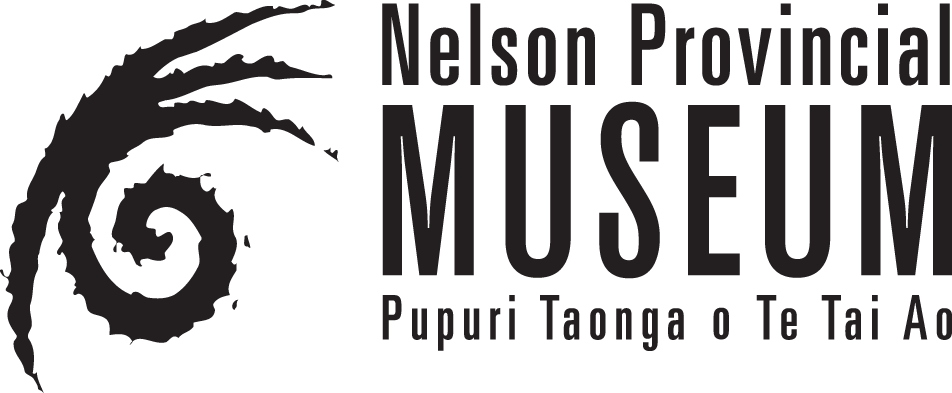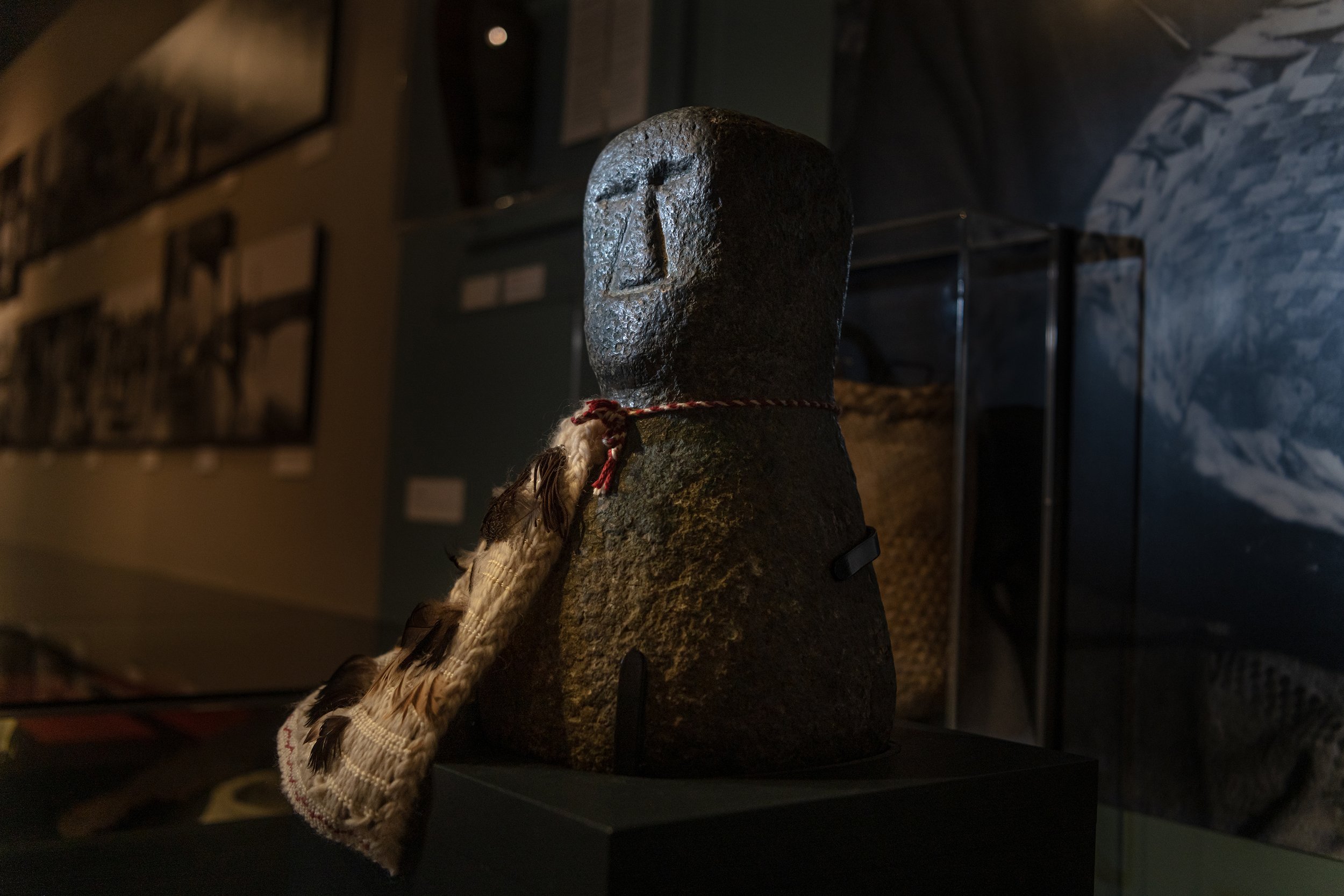Treasured taonga connects to early pā
RONGO-MĀ-TĀNE, NELSON PROVINCIAL MUSEUM COLLECTION, 117.51.
Visitors to Nelson Provincial Museum are invited to view, and even share mauri, with Te Rongo o Matangi Āwhio, which is on permanent display in the regional gallery.
Rongo is a small boulder of granodiorite crafted into the form of Rongo Mā Tāne, the atua (god) of cultivation and peace. The role of a rongo was to protect crops such as kūmara. The body has been roughly shaped to resemble a human figure using a technique called hammer dressing, where another stone is used to hammer and shape the edges.
Donated to the Museum in 1951, it has been on display since 2005, when the building on the corner of Trafalgar and Hardy Sts first opened its doors to the public. Today, the rongo is adorned with a contemporary korowai (cloak) woven by local artist Hinekawa Manihera (Ngāti Kuia, Ngāti Koata, Ngāti Apa ki te Rā Tō).
Hamuera Manihera is Nelson Provincial Museum’s Kaitiaki Taonga Māori (Māori Taonga Collections Manager) and says local iwi have kept their connection with the treasured taonga throughout the recent pandemic.
Manihera says the museum provided access to the rongo to ensure appropriate tikanga, or customary practices, could continue despite recent lockdowns and other Covid-19 restrictions.
While it’s quite rare to be able to touch a museum exhibit, Manihera said it’s been important to maintain access to support taonga tikanga, or customs around Māori treasures.
Through touch, he said, “we’ve kept the taonga warm.”
MABEL ANNESLEY (1881-1959), AFTER JOHN WALLIS BARNICOAT (1814-1905). AUCKLAND POINT IN 1843, CIRCA 1950. PENCIL DRAWING ON PAPER WITH A PINK TINT WASH. PROVINCIAL MUSEUM, BETT COLLECTION: AC450
Discovery at Matangi Āwhio
Local residents of Te Paruparu (Nelson Haven) discovered the rongo in the 1920s at what was once a pā site called Matangi Āwhio. The area has a long history of occupation dating back to 1450, when the tupuna (ancestor) Pohea established it as a fortified settlement.
Over almost seven centuries, the area has been occupied as a seasonal settlement, a permanent settlement and a tauranga waka (a place for safely landing waka). Following the arrival of the British, it became an important trading point for both Māori and Pākehā.
As the township of Whakatū grew, Matangi Āwhio continued to be a hub of activity with facilities developed to support trading, accommodation for Māori travelling for land court hearings and to gather for important hui and petitions. Today, it is the site of Nelson’s Auckland Point School.
The history and significance of Matangi Āwhio continues to be recognised by iwi of Te Tauihu with stories recounted through the generations.
According to these stories, Pohea named the pā Matangi Āwhio after the swirling sea breezes that blow in from Te Tai o Aorere (Tasman Bay).
Manihera said: “The reason Matangi Āwhio was chosen as a settlement site can be clearly seen through the natural landscape and associated resources in the area; two of the most predominant features being Te Taeroa a Kereopa and the Mahitahi (Maitai) river.”
AUCKLAND POINT, NELSON ABOUT 1846. BETT COLLECTION, NELSON PROVINCIAL MUSEUM: AC838
Te Taero a Kereopa (Boulder Bank)
Te Taero a Kereopa, more commonly known as The Boulder Bank, still plays an important role in sheltering Te Paruparu from the prevailing winds and the wild swells of Te Tai o Aorere.
A well-known Te Tauihu pūrākau (legend) tells the story of how the bank was created by Kereopa as he fled from Kupe. To prevent his capture, Kereopa performed a karakia causing boulders to fall from the nearby maunga (mountain) Horoirangi, which is the hill between Cable Bay and Glenduan known as Mackay Bluff. The boulders, which formed a long barrier, slowed Kupe in his pursuit of Kereopa.
“It is stories like these that have been passed down for generations recording place names and whakapapa connections to whenua,” said Manihera. “They create the relationship between tangata (people) and whenua (land). They are part of our living history.”
Today, Te Taero a Kereopa is internationally renowned, being the largest natural reef and boulder formation in the Southern Hemisphere.
The stone that makes up Te Taeroa a Kereopa is called granodiorite, which is one of the main hammer tools used to work pakohe (argillite) and onewa (greywacke). Local Māori used to craft tools from these stones, which would then be traded all around Aotearoa and even as far as Rēkohu (Chatham Islands).
NELSON AND AUCKLAND POINT. NELSON PROVINCIAL MUSEUM COLLECTION: C5241
Mahitahi (Maitai) River
To the east of Matangi Āwhio, the freshwater of the Mahitahi (Maitai) River flows into Te Paruparu. The Mahitahi–like many rivers of Nelson, Tasman, and Marlborough–could be considered a ‘waka huia’, a treasure box containing taonga such as wai (water), pakohe, onewa, and pounamu (greenstone).
In the past, when Matangi Āwhio thrived, the river also flowed with a wide range of other species such as tuna (eels), kanakana (lamprey), kōura (freshwater crayfish), īnanga (whitebait), whio (blue duck), pūtangitangi (paradise duck) and many others.
The Mahitahi River is fed by a mountain known as Maungatapu, which is situated between Whakatū (Nelson) and Te Hoiere (Pelorus River) and is one of the main sources of pakohe and onewa.
Today, local artists, including Frank Wells (Ngāti Kuia, Ngāti Apa ki te Rā Tō, Ngāti Koata) and Ruihana Hamuera (Ngāti Kuia, Ngāti Apa ki te Rā Tō), are highly regarded carvers of the stones.
A series of photographs and paintings of the Matangi Āwhio area are also available to view as part of the Museum’s online collection: search for Nelson Haven at https://collection.nelsonmuseum.co.nz/explore
This story was originally published in the Nelson Mail on Saturday 26th March, 2022. To view the story please click here.




